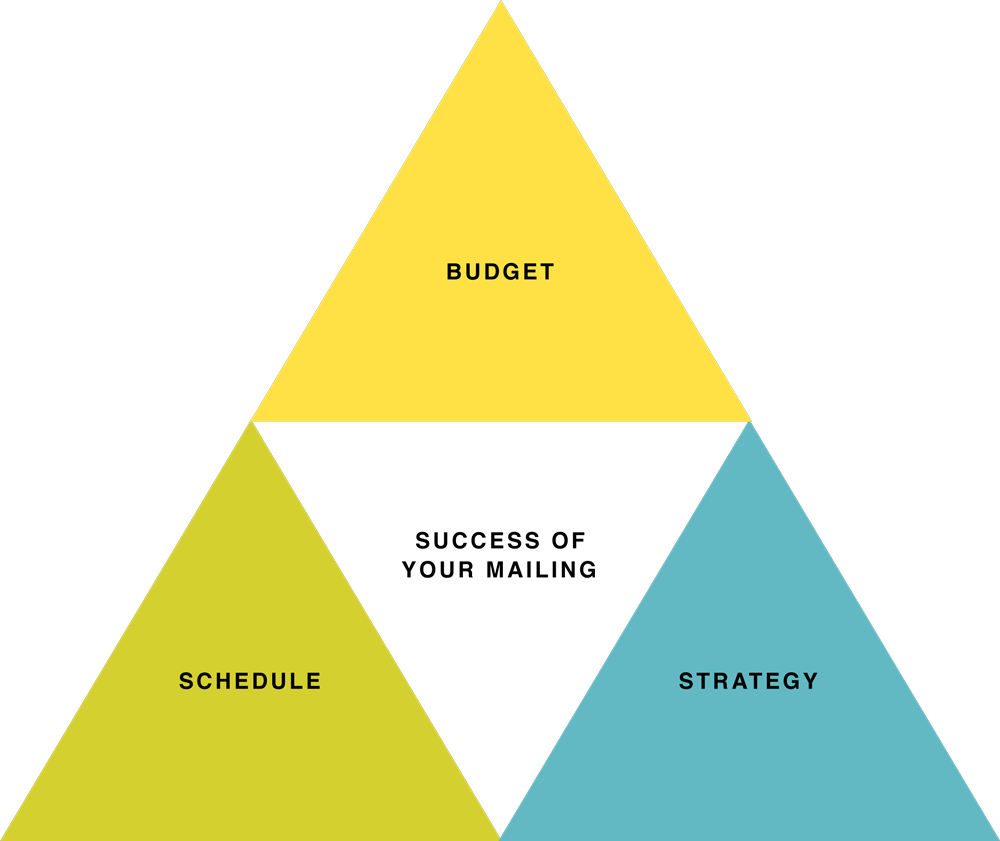A strategy roadmap


Now that you’ve got a great list full of worthwhile data, it’s time to map out where you want to go based on what you’ve determined about your audience. Putting time into strategic maintenance upfront is the fastest route to success.
Before creative even gets rolling, you need to determine what you want to offer and how you’re going to offer it. Marketing expert Ed Mayer advanced this formula for direct marketing in the sixties and the concept is still viable decades later.

40% audience
Forty percent of emphasis for direct mail marketing lies in determining the audience you are making your offer to.
40% offering
Forty percent of emphasis should be placed on what you are offering and how you are offering it.
20% creative
Twenty percent is focused on everything else: creative, format, paper, etc.
You could put all your effort into designing the most beautiful, creative and economical mailing, but none of that matters if the right people don’t see it. The same goes for “the message”; if it isn’t positioned correctly, all the bells and whistles in the world won’t make a difference.

Knowing your budget beforehand allows you to make informed decisions at future milestones in your campaign.
The best mail isn’t always the most expensive. It’s a balance of list, offer, timing, format and design. You can succeed or fail at either end of the cost spectrum, so it’s important to carefully consider all of the variables to determine how much you can and should spend on a mail campaign.
In addition to determining your fixed, variable and one-time costs, you’ll want to consider the following: cost of testing, cost associated with the offer, cost of media to support the mailing, and cost of additional support services. Defining a budget upfront helps you get the most for your money and ensure your final balance ends up in the black.
Working out the goals your campaign aims to achieve establishes necessary boundaries and gives your creative teams a refined positioning they will come back to if they get lost. Success, if left undefined, can be very subjective and emotional after the fact. Be sure to set realistic goals for each mailing and get buy-in from your team so that there is a defined goal to reference.
Bear in mind that success is not solely determined by ROI. Keep an eye on other measurable areas, such as converting a prospect into a customer or capturing new information you can use later, to get a truly accurate picture of how your campaigns perform.
Some questions to ask: How you will define the success of your mailing? Are you looking to convey a specific selling point that will lead to a short-term bump in profits? Or is your strategy more long-term, which means the campaign’s focus will be on building your brand?
Having a cohesive strategy and budget will allow you to work out a schedule for the campaign. If you have data, images and text available, you could probably get a mailpiece out in a couple of weeks. But since “spray and pray” mailings are no longer the only technique, it’s best to take the time to map out a full campaign, which can be more successful.
Predict every step along the way before the mailing gets sent to be sure you don’t miss any small details. Remember to add time for testing into your mailing schedule so your campaign can reach its maximum effectiveness. You may, for example, want to test a portion of a list before renting the entire thing to make sure it works. If you’re using sequential testing, you’ll need a few weeks after sending out the first round in order to measure the response and make adjustments.
The Butcher & Larder direct mail campaign had the following goals: Alert neighbors to the business’ new presence in the area, and find a way to personally meet the neighbors.
By defining the campaign objectives, the shop was able to develop an effective offer and a creative way to get customers in the door. Recipients of the campaign’s postcards were promised a free collectible poster that explained various cuts of meat when they presented the postcard at the store.
Using USPS’s Every Door Direct Mail program, the butcher blanketed part of the neighborhood with three mailings over three months. Because the posters were only given out in person and the campaign’s timeline was designed to spread out redemption, The Butcher & Larder was able to track its mailing impact and establish the brand’s attentiveness to individual customers.